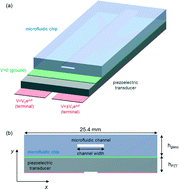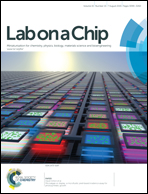Efficient coupling of acoustic modes in microfluidic channel devices
Abstract
This work introduces a new numerical simulation approach to acoustic microfluidic chip design based on coupled-resonator theory. A simplified acoustofluidic device operating in the transverse elastic mode is investigated and optimized for maximal pressure standing wave amplitude. This design approach provides insights into the symmetry and frequency characteristics of acoustic chip resonances that cannot be obtained from analysis based on wave propagation arguments. The new approach reveals that optimal performance requires spatial symmetry-matching and frequency-matching of the full device's elastic resonance to the channel's acoustic resonance. Symmetry selection is demonstrated for a three terminal piezoelectric transducer actuation scheme showing suppression of opposite-symmetry and enhancement of same-symmetry acoustic modes. Excitation of ultrasonic waves exhibits the anti-crossing behaviour predicted by coupled mode theory with the acoustic mode splitting into two distinct branches. Increased efficiency of energy transfer from the transducer into the fluid, with its corresponding increase in pressure amplitude, suggests a potential path toward significant increases in acoustic separator performance.


 Please wait while we load your content...
Please wait while we load your content...